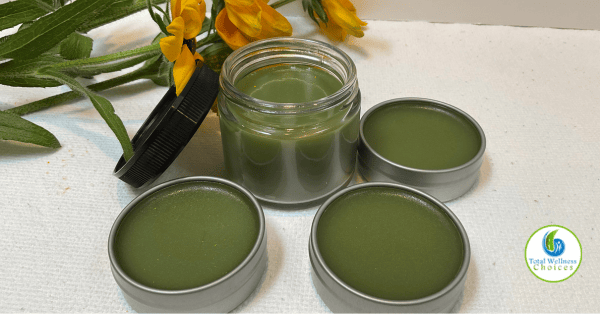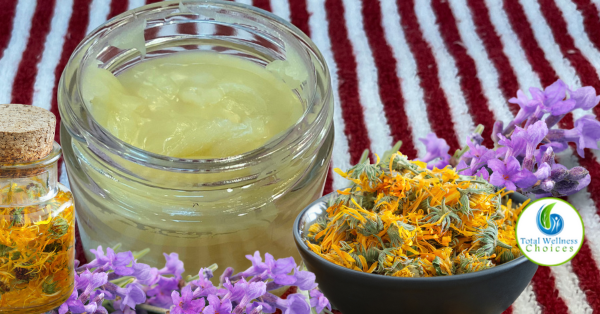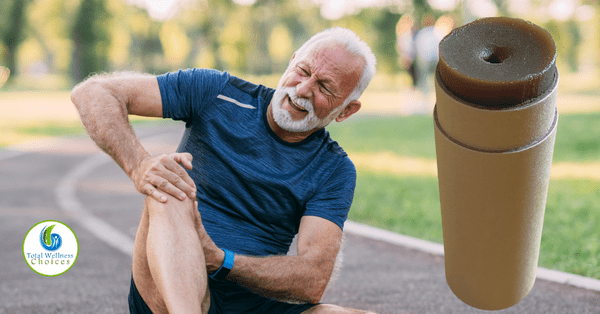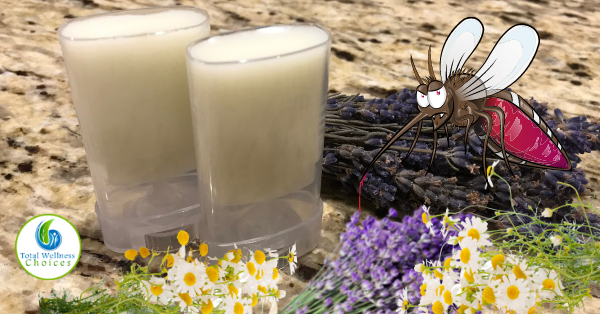Restorative Herbal Salve Recipe

Using Essential Oils Safely In A Bath
July 29, 2023
Amazing Peppermint Tea Health Benefits
February 25, 2024A Restorative Herbal Salve Recipe!
This is an easy to make herbal salve recipe that can be used for insect bites, on dry, cracked, and itchy skin areas, healing minor burns and wounds, and sprains, etc!
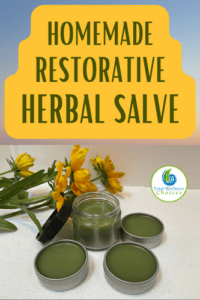 I like making products that are multipurpose types. This is one recipe that my family and I like using. We find it helpful for many things.
I like making products that are multipurpose types. This is one recipe that my family and I like using. We find it helpful for many things.
One use is after an insect bite or sting to soothe the area. Another use is on areas of itchy or irritated skin.
I have found this salve to be wonderful when used on patches of dry skin. I like to use it on my feet (especially the heels) and elbows.
My family and I have also found it helpful for minor burns. We apply this salve after the area has been treated with cool running tap water for 10 to 15 minutes, followed by a gentle washing with mild soap and water.
Another concern I find it helpful for is aiding the healing of scratches and abrasions. Once the area has started to scab over I apply a thin layer of this salve to help with the healing and to minimize scaring.
You may also find it helpful for easing aching muscles and joints, or to help with healing sprains.
The best part is that this restorative herbal salve uses some wonderful natural ingredients!
Herbs Used
The herbs I chose to infuse in an oil base are Calendula flowers, Comfrey leaf, and Plantain leaf. They work together in harmony to make the blend a stronger, more effective one.
I am using dried herbs as they are safer to use when infused in an oil base. There is less chance of mold and bacteria growth in the final product due to it being free of water – unlike fresh herbs that naturally retain water.
Calendula Flowers (dried)
Calendula (Botanical name: Calendula officinalis, C. arvensis) which also goes by its common names, pot marigold, and garden marigold is known for its warming, drying energetics.
It has many properties including: astringent, inflammatory and immune modulating (helps boost inflammatory and immune response), antimicrobial, antispasmodic, emmenagogue (stimulates blood flow in the pelvic area and uterus – menstrual flow), and slightly demulcent (produces substance that forms a soothing protective film over a mucous membrane).
Its uses range from numerous skin issues that include eczema, chicken pox, bug bites, itchy rashes, diaper rashes, minor wounds, scars, ulcers, minor infections, UV protection, sunburned skin, dry skin, supporting blood vessel health and decreasing varicosities (such as, varicose veins), and many more….
Comfrey Leaf (dried)
Comfrey (Botanical name: Symphytum officinale), also is known as common comfrey, is known for its cooling, moistening energetics.
It has many properties including: expectorant, demulcent, cell proliferant (aids in the healing action of the body by increasing cell growth and rejuvenation/granulation), and useful in healing wounds.
Its external uses range from helping varicose veins, and aiding in the healing of minor, clean wounds, broken bones, sprains and other musculoskeletal injuries, general back muscle pain, burns, and hernias.
It is said to work well for everyting, from the smallest of scratches, bruises and other boo-boos, to minor burns and rashes; as well as, more serious problems includng eczema, skin ulcers, healing wounds from surgery, sprains, broken bones, and rheumatic complaints.
Plantain Leaf (dried)
Plantain (Botanical names: Plantago major. P. lanceolata, P. rugelii, P. rhodosperma, P. virginica), also known as white man’s footstep, ribwort, and fleawort, is known for its cooling, moistening energetics.
It has many properties including: antimicrobial, anti-inflammatory, diuretic, demulcent (produces substance that forms a soothing protective film over a mucous membrane that helps relieve irritation or inflammation), expectorant, slightly astringent, and in treating wounds.
Its external uses range from aiding insect and spider bites, hot-itchy rashes, ulcers, minor cuts, scrapes and blisters, puncture wounds, burns, drawing out splinters and boils, and healing of tissues.
 Oils Used
Oils Used
I chose Sweet Almond Oil and Wheat Germ Oil as my oil base because they both have a good amount of Vitamin E, as well as, other skin nourishing nutrients which can be helpful for various skin problems.
The Vitamin E Oil was chosen to help extend the shelf life of my final product. Vitamin E is an antioxidant that helps to keep the oils, and thus the final product, from going rancid as fast as it would without.
Sweet almond oil is mild hypoallergenic oil that is easily absorbed into the skin. It is rich in Vitamin E and antioxidants thus making it great for the skin,. Sweet almond oil is an amazing moisturizer and helps protect one’s skin from the damage caused by UV rays of the sun.
This oil was used medicinally in ancient Chinese, Ayurvedic and Greco-Persian communities to treat dry skin conditions. Almond oil has been used for problems such as psoriasis and eczema. Is also used to smooth the skin and reduce scarring after surgery.
Almond oil is considered safe and non-irritating to use by most with sensitive skin. However, if you have an allergy to nuts it is suggested you use another oil, such as olive, grapeseed or avocado.
Wheat Germ Oil
Wheat germ oil comes from the embryo of the wheat seed, so it’s packed nutrients like potassium, selenium, zinc, iron, and phosphorus that your skin needs.
It’s also high in Vitamin E, which is a powerful antioxidant. It can help fight damage from free radicals and have some anti-aging properties. It also has vitamins A, B, and D which help to promote skin health.
Wheat germ oil is a wonderful carrier oil for dry skin, but it is a heavy oil thus using smaller amounts of this oil in a salve makes sense.
It can also have a strong odor, so you will usually mix it with another carrier oil to get the benefits of both oils minus the odor.
 Vitamin E Oil
Vitamin E Oil
Vitamin E oil is rich in antioxidants that inhibit free radicals that cause aging, hence, it helps to reduce the appearance of wrinkles and makes your skin look youthful. Even though there is no scientifuc proof it is thought by many to assist in healing scars, and help make the skin healthier.
For this salve Vitamin E oil is used because of its antioxidant action which helps to decrease rancidity in the final product thus extending its shelf life!
German Chamomile Essential Oil (AKA German Blue Chamomile EO)
German Chamomile Essential Oil (Chamomilla recutita) is known for the eye popping green to blue color it imparts. This color is the result of two constituents, chamazulene and (-)α-bisabolol (a sesquiterpene alcohol),
Other cooling and chamazulene-rich oils include Blue Tansy and Blue Yarrow. These two essential oils along with German blue chamomile are best noted for their complex aromas and skincare benefits.
German chamomile oil is used for providing a feeling of calmness and overall well-being, and it is wonderful at soothing sensitive skin. It is found helpful when used on minor skin irritations; such as, insect bites or red, congested skin.
Another use for German chamomile essential oil is to ease one’s aching muscles when over-exerted. It is used to help with sore joints, especially in the older population. Think arthritis!
Blue (German) Chamomile gives a wonderful herbaceous and fruity-floral fresh scent to many different types of skin care creams, lotions, salves, and massage blends. It also gave a pretty green look to my recipe!
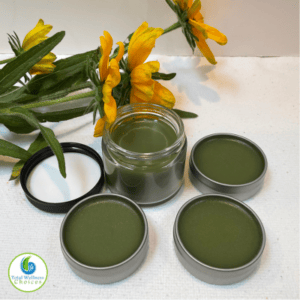
Restorative Herbal Salve Recipe
Ingredients Needed:
• 1/3 cup dried calendula flowers
• 1/3 cup dried comfrey leaf
• 1/3 cup dried plantain leaf
• 1/2 cup/120 ml (or more) sweet almond or cold-pressed extra virgin olive oil
• 1/4 cup/60 ml (or more) wheat germ oil
• 1/2 ounce beeswax, or candililla wax
• 20 to 30 drops German Chamomile Essential Oil
• 1/4 teaspoon Vitamin E oil
Making Recipe Using Slow Method (My preferred Method):
1. Place the dried calendula flower, comfrey leaf, and plantain leaf, in a small food processer, coffee grinder, or blender. Blend or grind until the plant material is broken down into powder.
2. Put the dried, now powder consistency, herbs in a 10 to 12 oz (300 ml to 355 ml) sized glass jar. Dried herbs should fill the jar 1/2 way.
3. Cover with the sweet almond oil (or olive oil) and wheat germ oil. (Make sure oil covers the herbs by 1 to 2 inches).
4. Put lid on jar securely. (I like to use a small square of parchment paper between jar and lid). Gently shake.
5. Place jar in cupboard, or cabinet.
6. Check on mix every one to three days and gently shake. Make sure herbs remain covered in oil. Add more oil if needed.
7. After six weeks remove from cupboard and strain the herbs through 2 layers of cheesecloth, or by using a nut bag, squeezing it well. (An optional method is to use a potato ricer).
8. Gather all ingredients, a double boiler, and prepare your salve tins or jars.
9. Measure out 1/2 cup of the infused oil. (If you are short on infused oil add some fresh sweet almond or olive oil).
10. Place beeswax, or candililla wax in double boiler over low heat. When almost melted add the infused oil and heat until the wax is totally melted. Remove from heat source.
11. Add German chamomile essential oil, and the Vitamin E oil. Stir well.
12. Immediately pour into prepared tins or jars. Let stand to cool and harden. Do not disturb while cooling. Once cooled, put on the lids.
Making Recipe Using Quick Method:
1. Gather all ingredients and prepare salve tins or jars.
2. Place the calendula flower, comfrey leaf, and plantain leaf, in a small food processer, coffee grinder, or blender. Blend or grind until the plant material is broken down into powder.
3. Add oils to a double boiler. Stir in the powdered herbs. Cover, leaving lid partially off to allow moisture to escape.
4. Heat on low until the oil is just hot to the touch. Once the oil is hot, turn off the heat. Let it sit.
5. Check oil a couple hours later. If it is cooled down, then repeat step #4. Continue repeating steps 4 and 5 regularly for next 12 hours.
Optional to steps 4 & 5: If you have a slow cooker or yogurt maker – you can set on lowest temp – with lid partially off. Check every few hours to make sure not boiling and that moisture is evaporating. Do for 24 to 48 hours.
6. Strain the herbs through 2 layers of cheesecloth, or using nut bag squeezing it well. An optional method is to use potato ricer!
7. Measure out 1/2 cup of the infused oil.
8. Place beeswax, or candililla wax in double boiler over low heat. When almost melted add the infused oil and heat until the wax is totally melted. Remove from heat.
9. Add German chamomile essential oil, and the Vitamin E oil. Stir well.
10. Immediately pour into the tins or jars. Let stand to cool and harden. Do not disturb while cooling. Once cooled, put on the lids.
Similar Recipes:
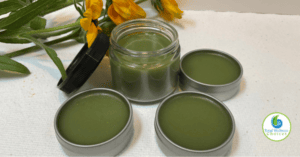
These statements have not been evaluated by the Food and Drug Administration. This article is for educational and informational purposes only and does not intend to diagnose, treat, cure, or prevent any disease or health condition. It is always recommended that you seek the advise of your private medical doctor.

